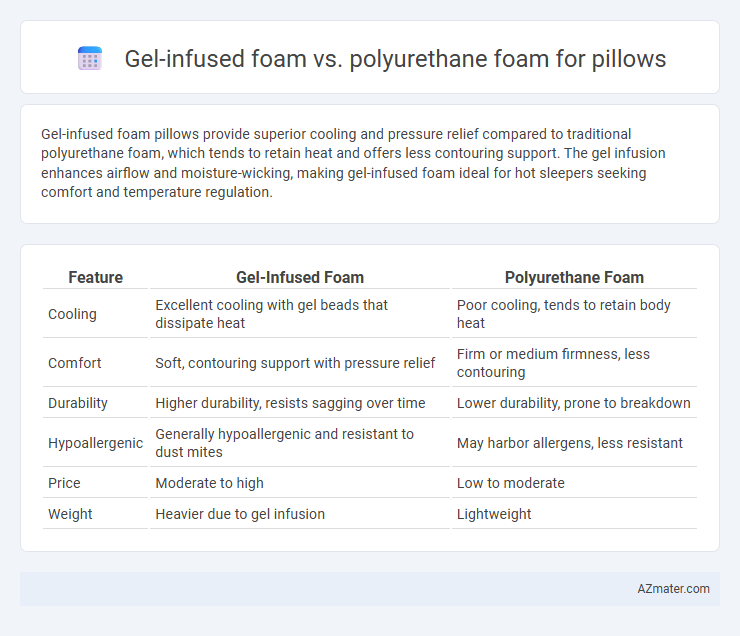Gel-infused foam pillows provide superior cooling and pressure relief compared to traditional polyurethane foam, which tends to retain heat and offers less contouring support. The gel infusion enhances airflow and moisture-wicking, making gel-infused foam ideal for hot sleepers seeking comfort and temperature regulation.
Table of Comparison
| Feature | Gel-Infused Foam | Polyurethane Foam |
|---|---|---|
| Cooling | Excellent cooling with gel beads that dissipate heat | Poor cooling, tends to retain body heat |
| Comfort | Soft, contouring support with pressure relief | Firm or medium firmness, less contouring |
| Durability | Higher durability, resists sagging over time | Lower durability, prone to breakdown |
| Hypoallergenic | Generally hypoallergenic and resistant to dust mites | May harbor allergens, less resistant |
| Price | Moderate to high | Low to moderate |
| Weight | Heavier due to gel infusion | Lightweight |
Introduction to Pillow Materials
Gel-infused foam pillows incorporate cooling gel beads within the foam matrix, enhancing temperature regulation and providing optimal support. Polyurethane foam pillows, known for their dense and firm structure, offer durable cushioning but can retain heat, potentially causing discomfort. Choosing between these materials depends on preferences for breathability, support, and temperature sensitivity during sleep.
What is Gel-Infused Foam?
Gel-infused foam is a type of memory foam that incorporates gel beads or liquid gel within its structure to enhance temperature regulation and provide a cooler sleep surface compared to traditional polyurethane foam. This infusion helps dissipate heat by increasing airflow and improving moisture wicking, making gel-infused foam ideal for individuals prone to overheating during sleep. Unlike standard polyurethane foam, which tends to retain heat and compress over time, gel-infused foam offers improved breathability and consistent pressure relief for enhanced comfort.
What is Polyurethane Foam?
Polyurethane foam is a versatile synthetic material commonly used in pillows for its durability and supportive properties. It consists of flexible polymer chains that provide a balance of softness and firmness, adapting to the sleeper's head and neck for enhanced comfort. Unlike gel-infused foam, polyurethane foam lacks cooling technology but excels in resilience and cost-effectiveness.
Temperature Regulation: Gel-Infused vs Polyurethane
Gel-infused foam pillows offer superior temperature regulation by incorporating cooling gel beads that dissipate heat and maintain a cooler sleep surface. Polyurethane foam typically retains body heat, which can lead to a warmer pillow and potential discomfort from overheating during the night. The advanced thermal conductivity of gel-infused foam directly enhances breathability and reduces night sweats, making it ideal for hot sleepers compared to standard polyurethane foam.
Support and Comfort Comparison
Gel-infused foam pillows provide enhanced cooling properties by dissipating heat more effectively than traditional polyurethane foam, promoting a comfortable sleep environment. The gel infusion offers better pressure relief and contouring support, conforming closely to the head and neck to reduce stiffness and soreness. Polyurethane foam, while supportive, tends to retain heat and may lack the adaptive comfort that gel-infused foam delivers, making gel-infused options superior for personalized support and overall sleep comfort.
Durability and Longevity
Gel-infused foam pillows offer enhanced durability by maintaining their shape and firmness longer than traditional polyurethane foam, which tends to break down and become lumpy over time. The gel infusion improves heat dissipation, reducing material degradation caused by trapped heat and moisture. High-density polyurethane foam can also be durable, but gel-infused foam typically provides superior longevity and consistent support for extended pillow use.
Allergen Resistance and Health Factors
Gel-infused foam pillows offer superior allergen resistance due to their open-cell structure, which inhibits dust mites and mold growth compared to traditional polyurethane foam. The antimicrobial properties of gel-infused foam contribute to a healthier sleep environment by reducing common allergens that trigger respiratory issues. Polyurethane foam, while supportive, tends to retain heat and moisture, creating a less hypoallergenic surface that may aggravate allergies over time.
Price Differences and Value
Gel-infused foam pillows generally cost more than standard polyurethane foam due to advanced cooling technology and enhanced comfort features. Despite the higher price, gel-infused foam offers better temperature regulation and durability, providing greater long-term value for sleepers. Polyurethane foam pillows are more budget-friendly but may lack breathability and support, potentially reducing their overall lifespan and comfort.
Ideal Users for Each Pillow Type
Gel-infused foam pillows are ideal for hot sleepers and individuals seeking enhanced temperature regulation due to the gel's cooling properties. Polyurethane foam pillows suit users desiring firm support and durability, often preferred by people with neck pain or those who favor a traditional foam feel. Side and back sleepers typically benefit more from gel-infused options, while polyurethane foam caters well to stomach sleepers needing consistent pressure distribution.
Final Verdict: Choosing the Right Foam Pillow
Gel-infused foam pillows offer superior temperature regulation and pressure relief, making them ideal for hot sleepers and those seeking enhanced comfort. Polyurethane foam pillows provide a more affordable, firmer support but may retain heat and offer less contouring. Selecting the right foam pillow ultimately depends on individual sleep preferences, with gel-infused foam excelling in cooling and comfort, while polyurethane foam suits budget-conscious users seeking durability.

Infographic: Gel-infused foam vs Polyurethane foam for Pillow
 azmater.com
azmater.com